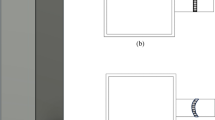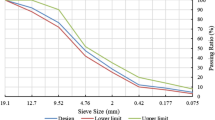Abstract
The gob-side entry retaining (GER) technique enables pillarless coal mining by using roadside backfilling body (RBB). Due to the advantages of fast curing and high bearing capability after a large post-peak deformation, high-water material is commonly used to construct the RBB. The post-peak properties of the high-water material sample and the concrete sample were compared through uniaxial compression test (UCT) and acoustic emission (AE) test. It is found that the uniaxial compressive strength (UCS) of the high-water material sample is 10.29 MPa with a relatively high post-peak strength. When the strain of the high-water material sample is 12.7 times that of the concrete sample, the loading capacity of the high-water material sample remains 59% of UCS. It is shown that the internal damage of the high-water material sample is very slow in the post-peak stage and remains much less undamaged than the concrete sample. The procedures of GER were studied by numerical simulation. The numerical results suggested that the high-water material roadside backfilling body (HMRBB) underwent elastic deformation, followed by plastic deformation as the panel advanced. The loading stress in RBB increased first and decreased to 74% of its peak strength. The final deformation of the backfilling side was 9% of its width. In the field, the post-peak bearing capacity of HWRBB was pronouncedly enhanced after the bolt reinforcement, leading to a 56% decrease of the deformation of the backfilling body side. The deformation and loading capacity of the backfilling body satisfied the safe operation requirements.










Similar content being viewed by others
Abbreviations
- σpc :
-
Peak strength of concrete sample
- σ sc :
-
Residual strength of concrete sample
- σ pw :
-
Peak strength of high-water material sample
- D :
-
Damage variable of the material
- C 0 :
-
Total ring-down counts at which the rock sample is completed damaged
- C d :
-
Accumulated ring-down counts
- σ lt :
-
Strength of sample at loading termination
- σ p :
-
Peak strength of sample
- P :
-
Load on the backfilling body
- q :
-
Weight of the overlying strata
- M1, M2 :
-
Force from the adjacent blocks applied to the key block above the backfilling body
- F g :
-
Support force from the gangue to the key block
- L :
-
Key block length
- x 1 :
-
Distance between the action points of the backfilling body to the hinge point
- x 2 :
-
Distance between the gangue to the hinge point
- AE:
-
Acoustic emission
- GER:
-
Gob-side entry retaining
- HM:
-
High-water material
- HMRBB:
-
High-water material roadside backfilling body
- MTS:
-
Material Testing System
- RBB:
-
Roadside backfilling body
- UCS:
-
Uniaxial compressive strength
- UCT:
-
Uniaxial compression test
- W/I:
-
Water to ingredient
References
Bai JB, Zhou HQ, Hou CJ et al (2004) Development of support technology beside roadway in gob-side entry retaining for next sublevel. J China Univ Min Technol 33(2):183–186
Bai JB, Shen WL, Guo GL, Wang XY, Yu Y (2015) Roof deformation, failure characteristics, and preventive techniques of gob-side entry driving heading adjacent to the advancing working face. Rock Mech Rock Eng 48:2447–2458
Cheng JY, Li WF, Zhang P (2015) A novel backfill material for roof supports in the cut-through entries of longwall mining. Technical Gazette 22(1):201–208
Fall M, Benzaazoua M, Ouellet S (2005) Experimental characterization of the influence of tailings fineness and density on the quality of cemented paste backfill. Miner Eng 18(1):41–44
Gong P, Ma ZG, Zhang RC, Ni XY, Liu F, Huang ZM (2017) Surrounding rock deformation mechanism and control technology for gob-side entry retaining with fully mechanized gangue backfilling mining: a case study. Shock Vib 2017:1–15. https://doi.org/10.1155/2017/6085941
Han CL, Zhang N, Xue JH, Kan JG, Zhao YM (2018) Multiple and long-term disturbance of gob-side entry retaining by grouped roof collapse and an innovative adaptive technology. Rock Mech Rock Eng. https://doi.org/10.1007/s00603-018-1612-0
He MC, Gao YB, Yang J, Gong WL (2017) An innovative approach for gob-side entry retaining in thick coal seam longwall mining. Energies 10:1785
He QY, Li YC, Xu JH, Zhang CG (2020) Prediction of mechanical properties of igneous rocks under combined compression and shear loading through statistical analysis. Rock Mech Rock Eng 53:841–859. https://doi.org/10.1007/s00603-019-01948-9
Itasca Consulting Group Inc. (2016) FLAC3D (3D Fast Lagrangian Analysis Code), Version 6.0. Itasca, Minneapolis
Kachanovl M (1958) Time rupture process under creep conditions. Izvestia Akademii Nauk SSSR Otdelenie Tekhnicheskich Nauk 8:26–31
Kan JG, Zhang N, Wu JK, Wu H (2013) Effect of main roofs fracture position on the secondary gob-side entry retaining stability. Disaster Adv 6:189–199
Khaldoun A, Ouadif L, Baba K, Bahi L (2016) Valorization of mining waste and tailings through paste backfilling solution, Imiter operation, Morocco. Int J Min Sci Technol 26(3):511–516
Krupnik LA, Shaposhnik YN, Shaposhnik SN, Tursunbaeva AK (2013) Backfilling technology in Kazakhstan mines. J Min Sci 49(1):82–89
Li WF, Bai JB, Peng S, Wang X, Xu Y (2015a) Numerical modeling for yield pillar design: a case study. Rock Mech Rock Eng 48:305–318
Li XH, Ju MH, Yao QL et al (2015b) Numerical investigation of the effect of the location of critical rock block fracture on crack evolution in a gob-side filling wall. Rock Mech Rock Eng 49:1041–1058
Li HZ, Guo GJ, Zhai SC (2016) Mining scheme design for super-high-water backfill strip mining under buildings: a Chinese case study. Environ Earth Sci 75:1017. https://doi.org/10.1007/s12665-016-5837-5
Li HJ, Zhang YC, Xu L, Jia X, Gu X (2017) Examination of the treatment quality of filling mined-out voids using super-high-water material by the TEM technique. Environ Earth Sci 76. https://doi.org/10.1007/s12665-017-6431-1
Li YC, Tang CA, Li DQ, Wu CZ (2019) A new shear strength criterion of three-dimensional rock joints. Rock Mech Rock Eng:1–7. https://doi.org/10.1007/s00603-019-01976-5
Ning JG, Wang J, Bu TT, Hu SC, Liu XS (2017) An innovative support structure for gob-side entry retention in steep coal seam mining. Minerals 7:75
Salamon MDG. (1990) Mechanism of caving in longwall coal mining. Rock mechanics contribution and challenges: proceedings of the 31st US symposium of rock mechanics. Golden, Colorado, pp 161–168
Sun Q, Zhang JX, Zhang Q, Yan H (2018) A case study of mining-induced impacts on the stability of multi-tunnels with the backfill mining method and controlling strategies. Environ Earth Sci 77(6):234
Sunil P, Weiss J, et al. (2006) Assessment of localized damage in concrete under compression using acoustic emission. DOI: https://doi.org/10.1061/(ASCE)0899-1561-(2006)18:3(325)
Tan YL, Yu FH, Ning JG, Zhao TB (2015) Design and construction of entry retaining wall along a gob side under hard roof stratum. Int J Rock Mech Min Sci 77:115–121
Wang H, Zhang D, Fan G (2011) Structural effect of a soft–hard backfill wall in a gob-side roadway. Min Sci Technol 21:313–318. https://doi.org/10.1016/j.mstc.2011.05.001
Wang M, Bai JB, Li WF, Wang XY, Cao SG (2015) Failure mechanism and control of deep gob-side entry. Arab J Geosci 8:9117–9131
Wang HS, Zhang DS, Liu L, Guo WB, Fan GW, Song KI, Wang XF (2016) Stabilization of gob-side entry with an artificial side for sustaining mining work. Sustainability. 8:627
Wu BW, Wang XY, Bai JB, Wu W, Zhu X, Li G (2019) Study on crack evolution mechanism of roadside backfill body in gob-side entry retaining based on UDEC trigon model. Rock Mech Rock Eng 52:3385–3399. https://doi.org/10.1007/s00603-019-01789-6
Yan S, Bai J, Wang X, Huo L (2013) An innovative approach for gateroad layout in highly gassy longwall top coal caving. Int J Rock Mech Min 59:33–41. https://doi.org/10.1016/j.ijrmms
Yan S, Liu TX, Bai JB, Wu W (2018) Key parameters of gob-side entry retaining in a gassy and thin coal seam with hard roof. Process. https://doi.org/10.3390/pr6050051
Yang YJ, Wang DC, Guo MF et al (2014) Study of rock damage characteristics based on acoustic emission tests under triaxial compression. Chin J Rock Mech Eng 33(1):98–104
Yang HY, Cao SG, Wang SQ, Fan Y, Wang S, Chen X (2016) Adaptation assessment of gob-side entry retaining based on geological factors. Eng Geol 209:143–151
Yavuz H (2004) An estimation method for cover pressure re-establishment distance and pressure distribution in the goaf of longwall coal mines. Int J Rock Mech Min Sci 41(2):193–205
Zhang YQ, Tang JX (2014) Spontaneous caving and gob-side entry retaining of thin seam with large inclined angle. Int J Min Sci Technol 24(4):441–445
Zhang N, Yuan L, Han C, Xue J, Kan J (2012) Stability and deformation of surrounding rock in pillarless gob-side entry retaining. Saf Sci 50(4):593–599
Zhang ZZ, Bai JB, Chen Y, Yan S (2015) An innovative approach for gob-side entry retaining in highly gassy fully-mechanized longwall top-coal caving. Int J Rock Mech Min Sci 80:1–11
Zhang ZY, Shimada H, Qian DY, Sasaoka T (2016) Application of the retained gob-side gateroad in a deep underground coalmine. Int J Min Reclam Environ 30:371–389
Zhang ZY, Zhang N, Shimada H, Sasaoka T, Wahyudi S (2017) Optimization of hard roof structure over retained goaf-side gateroad by pre-split blasting technology. Int J Rock Mech Min 100:330–337
Zhang ZZ, Yu XY, Wu H, Deng M (2019) Stability control for gob-side entry retaining with supercritical retained entry width in thick coal seam longwall mining. Energies. 12(7):1375
Acknowledgements
The authors thank Xinyuan coal mine for their support during the field work.
Funding
This research was financially supported by the Fundamental Research Funds for the Central Universities (2017XKZD06).
Author information
Authors and Affiliations
Corresponding author
Ethics declarations
Conflict of interest
The authors declare that there are no conflicts of interest.
Additional information
Responsible Editor: Zeynal Abiddin Erguler
Rights and permissions
About this article
Cite this article
Zhang, Ft., Wang, Xy., Bai, Jb. et al. Post-peak mechanical characteristics of the high-water material for backfilling the gob-side entry retaining: from experiment to field application. Arab J Geosci 13, 386 (2020). https://doi.org/10.1007/s12517-020-05369-9
Received:
Accepted:
Published:
DOI: https://doi.org/10.1007/s12517-020-05369-9




